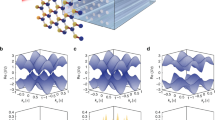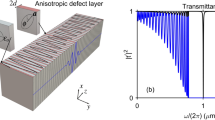Abstract
Optical bistability and symmetry breaking under the conditions of plane wave incidence on a system of coupled photonic crystal microcavities containing an inclusion with Kerr susceptibility have been studied. The T-matrix modal method has been generalized for the case of nonlinear microcavities supporting one monopole mode. It has been shown that both phenomena considerably depend not only on external field strength but also on angle of incidence and photonic crystal size.













Similar content being viewed by others
REFERENCES
D. N. Neshev, A.A Sukhorukov, W. Krolikowski, Y. S. Kivshar, and S. Lan, J. Nonlin. Opt. Phys. Mater. 16, 1 (2007).
J. Bravo-Abad, A. Rodriguez, P. Bermel, S. G. Johnson, J. D. Joannopoulos, and M. Soljačič, Opt. Express 15, 16161 (2007).
A. R. McGurn and G. Birkok, Phys. Rev. E 69, 235105 (2004).
A. E. Miroshnichenko, S. F. Mingaleev, S. Flach, and Y. S. Kivshar, Phys. Rev. E 71, 036626 (2005).
K. Frizyuk, J. Opt. Soc. Am. B 8, F32 (2019).
A. R. McGurn, Phys. Rev. B 77, 115105 (2008).
J. Bravo-Abad, S. Fan, S. G. Johnson, J. D. Joannopoulos, and M. Soljačič, J. Light. Technol. 25, 2539 (2007).
M. Soljačič, E. Lidorikis, J. D. Joannopoulos, and L. V. Hau, Appl. Phys. Lett. 86, 171101 (2005).
D. Vujic and S. John, Phys. Rev. A 72, 013807 (2005).
E. Bulgakov, K. Pichugin, and A. Sadreev, J. Phys.: Condens. Matter 25, 395304 (2013).
X.-S. Lin, W.-O. Wu, H. Zhou, K.-F. Zhou, and S. Lan, Opt. Express 14, 2429 (2006).
S. F. Mingaleev and Y. S. Kivshar, J. Opt. Soc. Am. 19, 2241 (2002).
S. F. Mingaleev, A. E. Miroshnichenko, Y. S. Kivshar, and K. Busch, Phys. Rev. E 74, 046603 (2006).
L. Yuan and Y. Y. Lu, SIAM J. Appl. Math. 80, 864 (2020).
M. Bahl, N. C. Panoiu, and I. V. Iorsh, Jr., Phys. Rev. E 67, 056604 (2003).
A.Rodriguez, M. Soljačič, J. D. Joannopoulos, and S. G. Johnson, Opt. Express 15, 7303 (2007).
J. Wang, M. Clementi, M. Minkov, A. Barone, J.‑F. Carlin, N. Grandjean, D. Gerace, S. Fan, M. Galli, and R. Houdr’e, Optica 7, 1126 (2020).
H. M. Gibbs, Optical Bistability: Controlling Light with Light (Academic, New York, 1985).
F. Zhou, Y. Liu, Z-Y. Li, and Y. Xia, Opt. Express 18, 13337 (2010).
Y. Liu, F. Qin, Y. Xia, F. Zhou, and Z.-Y. Lia, J. Appl. Phys. 106, 083102 (2009).
E. N. Bulgakov and A. F. Sadreev, J. Opt. Soc. Am. B 29, 2924 (2012).
M. M. Mazumder, S. C. Hill, D. Q. Chowdhury, and R. K. Chang, J. Opt. Soc. Am. B 12, 297 (1995).
M. F. Yanik, S. Fan, and M. Soljačič, Appl. Phys. Lett. 83, 2739 (2003).
E. N. Bulgakov, K. N. Pichugin, and A. F. Sadreev, Opt. Express 23, 20636 (2015).
J. D. Joannopoulos, S. G. Johnson, J. N. Winn, and R. D. Meade, Photonic Crystals: Molding Flow of Light (Princeton Univ. Press, Princeton, 2008).
K. Koshelev, G. Favraud, A. Bogdanov, Y. Kivshar, and A. Fratalocchi, Nanophotonics 8, 725 (2019).
D. Dolinina and A. Yulin, Opt. Lett. 45, 3781 (2020).
S. D. Krasikov, A. A. Bogdanov, and I. V. Iorsh, Phys. Rev. B 97, 224309 (2018).
A. Chukhrov, S. Krasikov, A. Yulin, and A. A. Bogdanov, Phys. Rev. B 103, 214312 (2021).
L. Yuan and Y. Y. Lu, Phys. Rev. A 94, 013852 (2016).
L. Yuan and Y. Y. Lu, Phys. Rev. A 95, 023834 (2017).
L. Yuan and Y. Y. Lu, Opt. Express 23, 20636 (2015).
Q. Yang, Y. Liu, X. Gan, C. Fang, G. Han, and Y. Hao, IEEE Photon. J. 12, 4601209 (2020).
E. N. Bulgakov and D. N. Maksimov, Sci. Rep. 9, 7153 (2019).
D. N. Maksimov, A. A. Bogdanov, and E. N. Bulgakov, Phys. Rev. A 102, 033511 (2020).
E. N. Bulgakov and A. F. Sadreev, Phys. Rev. A 99, 033851 (2019).
T. Peschel, U. Peschel, and F. Lederer, Phys. Rev. A 50, 5153 (1994).
L. Yuan, in Proceedings of the 2015 IEEE International Conference on Computational Electromagnetics (2015), p. 212.
L. Yuan and Y. Y. Lu, Opt. Express 22, 30128 (2014).
B. Maes, M. Soljačič, J. D. Joannopoulos, P. Bienstman, R. Baets, S.-P. Gorza, and M. Haelterman, Opt. Express 14, 10678 (2006).
E. Bulgakov, A. Sadreev, and K. Pichugin, in Progress in Optical Science and Photonics (2013), p. 89.
E. N. Bulgakov and A. F. Sadreev, Phys. Rev. E 86, 075125 (2012).
A. Mirzaei, A. E. Miroshnichenko, N. A. Zharova, and I. V. Shadrivov, J. Opt. Soc. Am. B 31, 1595 (2014).
E. Bulgakov and A. Sadreev, J. Phys.: Condens. Matter 23, 315303 (2011).
L. Yuan and Y. Y. Lu, Opt. Express 21, 11952 (2013).
E. Centeno and D. Felbacq, Phys. Rev. B 62, 7683 (2000).
T. Christopoulos, O. Tsilipakos, and E. E. Kriezis, Opt. Lett. 45, 6442 (2020).
Y. Liang, C. Peng, K. Sakai, S. Iwahashi, and S. Noda, Opt. Express 20, 15945 (2012).
K. Yasumoto, Electromagnetic Theory and Applications for Photonic Crystals (Taylor and Francis Group, London, 2006).
M. I. Mishchenko, L. D. Travis, and A. A. Lacis, Scattering, Absorption, and Emission of Light by Small Particles (Goddard Inst. Space Studies, 2004).
Funding
This study was supported by the Russian Science Foundation, grant no. 22-12-00070.
Author information
Authors and Affiliations
Corresponding author
Ethics declarations
The authors declare that they have no conflicts of interest.
Additional information
Translated by V. Isaakyan
APPENDIX
APPENDIX
The solution of the problem of plane wave scattering by a set of dielectric cylinders with permittivity ε will be described with the T-matrix model method [50].
We will follow the approach used in [49]. In this method, the electric field is expanded in cylindrical harmonics both inside and outside of the jth cylinder in a local coordinate system (see Fig. 14):
Here, k0 = ω/c, coefficients ajm are the harmonic amplitudes of the field incident on the jth cylinder, and bjm are the amplitudes of the scattered field. Amplitudes ajm are presented in the form
where
is the amplitude of the plane wave incident on the system and (Rj, θj) are the coordinates of the jth cylinder relative to the global coordinate system. Amplitudes \(a_{{j,m}}^{{{\text{rods}}}}\) represent the field scattered from the rest of cylinders (l ≠ j). Using the Graph formula, one can relate amplitudes \(a_{{j,m}}^{{{\text{rods}}}}\) to scatt1ered wave amplitudes bl, m (l ≠ j):
From (5)–(7), we obtain
where
To close system (8), we use coupling between amplitudes (bj) and (aj) through the diagonal t-matrix:
where
Thus, we arrived at a set of linear equations for amplitudes bj:
If the permittivity of the cylinders contains a Kerr nonlinear correction, ε = ε0 + λ|Ez(r)|2, formula (15) remains valid if coupling between amplitudes \({\mathbf{b}}_{j}^{{({\text{nonlin}})}}\) and \({\mathbf{a}}_{j}^{{({\text{nonlin}})}}\) through the nonlinear t-matrix is known:
The existence of such coupling in the form of formula (6) is not obvious. Below, an explicit expression for \(\hat {t}_{j}^{{({\text{nonlin}})}}\) will be derived under two conditions: (i) nonlinear cylinders are placed only in resonant cavities and (ii) a monopole mode is excited in each cavity in the case of light resonance scattering, when nonlinearity becomes a critical factor; that is, s-scattering by nonlinear cylinders dominates.
The equation for the Ez component of the field at the nonlinear cylinder in the cylindrical coordinate system has the form
As before, the wave function is sought in the form of a series:
After (18) is substituted into (17), the latter can approximately be represented as a set of uncoupled equations:
The nonlinear term should be taken into account only in the equation for ψ0, since |ψm| ≪ |ψ0| at resonance s-scattering. In the absence of resonance, the nonlinearity term can be ignored. Thus, the solution of the problem reduces to the solution of Eq. (19b). This equation can be solved approximately using the perturbation theory with the consideration of the fact that λ|ψ0|2 ≪ ε0 even at resonance scattering.
To this end, let us cast an auxiliary boundary-value problem:
with
In what follows, we put ψ ≡ ψ0. The problem can be solved using Green’s function g(r):
with
Equation (21) has an explicit solution:
where r> = max(r, ρ) and r< = min(r, ρ). Then, Eq. (20) has the formal solution
It is easy to check that
where
Then, at λ = 0, we have
Now, integral equation (23) can be written as
where
In the limit λ → 0, Eq. (26) can be approximately solved by iteration. In the first Born approximation, we have
Correction term ψcorr(r) can be reduced to the form
where
Note that ψcorr(r = R) = 0. To sew together solution (27) inside the cylinder and the external solution, it is necessary to know \(\psi _{{{\text{corr}}}}^{'}\)(r = R). This derivative is found from Eq. (28):
Then, the approximate solution inside the cylinder takes the form
where
Now we sew together the internal solution and external solution
to obtain
where t0 is the element of diagonal t-matrix (14) at resonance scattering.
To eliminate parameter A from expression (31), one can take its value from the linear problem (λ = 0):
Then,
where
Thus, formula (33) sets necessary coupling between amplitudes a0 and b0. As a result, formula (15) in the nonlinear case takes the form
where
and Nk is a set of nonlinear cylinders. In essence, Eq. (34) represents a closed set of equations for amplitudes bj. In computer calculations, azimuthal number m takes a finite series of values: m ∈ [–M, –M + 1, …, +M].
Rights and permissions
About this article
Cite this article
Shadrina, G.V., Bulgakov, E.N. Optical Bistability and Symmetry Breaking at Resonance Scattering of Light by a Finite Photonic Crystal with a Nonlinear Resonant Cavity. J. Exp. Theor. Phys. 135, 632–641 (2022). https://doi.org/10.1134/S1063776122110176
Received:
Revised:
Accepted:
Published:
Issue Date:
DOI: https://doi.org/10.1134/S1063776122110176





